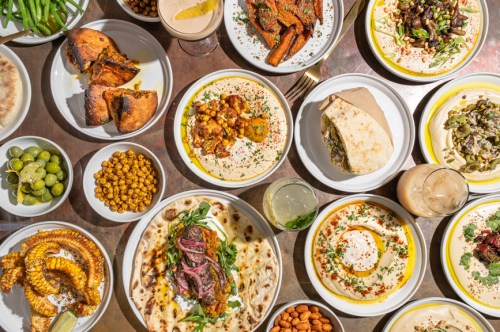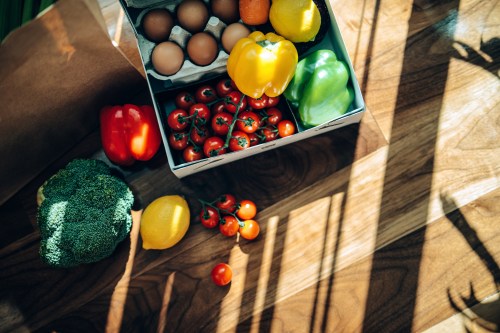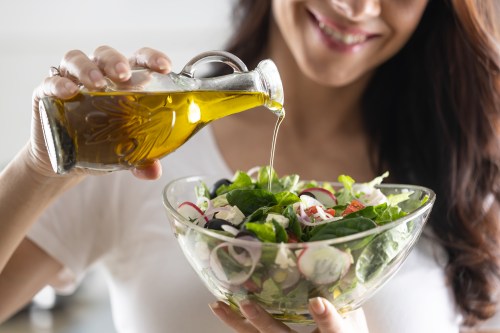This past fall, I was fortunate enough to be invited on a weeklong food and wine tour across Israel. (Food writing is a tough job, but someone’s gotta do it.) My mouth instantly started to water at the prospect of feasting on Mediterranean-meets-Middle Eastern fare. Think: hot-out-of-the-oven pitas, fresh-caught fish, and plant-based spreads and salads aplenty—naturally served alongside a glass of vino or a chilled bottle of Goldstar, the country’s most famous domestic beer. But more than that, I was thrilled to revisit the place I called home for most of my 20s: Tel Aviv, which would be our final destination.
The day after landing, my group went on a whirlwind tour of Jerusalem. We buzzed through the Old City markets, visited historical landmarks (the Western Wall, Church of the Holy Sepulchre, and Ramparts Walk, among others), and indulged in tastings at a local gin distillery and the famous Machne Yehuda food market. I ravenously indulged in the Israeli hummus—topped with chickpeas and parsley and doused in olive oil and lemon—I hadn’t devoured in years. The old saying rings true: Good things are worth the wait. After Jerusalem, we spent three days in the Galilee, a popular region for religious pilgrimages and winemaking. The whirlwind continued on, as my itinerary packed in tours of everything from churches, all sorts of farms (honey, cheese, you name it), and dessert shops to what felt like 100 wineries (but more accurately clocked in at about six).
We finally made our way to Tel Aviv on the penultimate day of the trip. We stopped first in Jaffa, a port city on Tel Aviv’s southern edge… and that’s when the memories began to trickle in. Eating chicken shawarma alongside hefty salads and extra zhoug (spicy sauce)—then walking it off on Jaffa’s uneven, ancient terrain—had me recollect all the brunching and cheers-ing l’chaim I’d done on these very streets in years past. My friends and I would cap things off by watching the sun set over the calm and clear Mediterranean sea; the sounds of the waves crashing and matkot balls ricocheting off one beachgoer’s paddle to the next were like a Levantine lullaby.
After having free time to meet with friends that evening—most of whom I hadn’t seen since moving back to the states over four years prior—I woke up on Friday morning to make it to the final destination of the trip: Shuk HaCarmel, the city’s central food market. I’d eagerly awaited this tour the most. I’d previously lived in Kerem HaTeimanim (the Yemenite Quarter), which directly borders the market and has reinvented itself over the past decade to include trendy cafes, bars, and international eateries.
Back in the day, I knew the market and its overlapping neighborhoods like the back of my hand: which sellers sold the freshest produce, which bread stalls baked the tastiest loaves, where to find the best kebab… you name it. But with each step I took through my old neighborhood, winding in and out of the main drag of the market, the pangs of nostalgia began to settle in—and fast.
I walked past my former apartments as well as those of my friends. Awestruck, I remembered the good times I had during what I consider to be the happiest period of my life. But things started to get more bittersweet when I strolled the sites of my former go-to stalls and eateries my friends had owned that had since closed and been replaced. My throat closed up as I bit into a super sweet knafeh pastry at the exact location where I’d had my first melt-in-your-mouth Yemenite beef soup with my favorite neighbor… though the original restaurant had long since shut down. I saw a sandwich shop that had replaced the counter for bunny chow (a South African curry in a bread bowl), where I’d sit and chat with the staffers for hours—even if I arrived with a full stomach. Also gone was the Greek restaurant my friend owned and where I celebrated one of my liveliest birthday parties. It felt chilling to see the relics of my past very much there, but at the same time quite obviously not. And even more so since I no longer was the younger, more spirited version of my Tel Avivian past.
It felt chilling to see the relics of my past very much there, but at the same time quite obviously not. And even more so since I no longer was the younger, more spirited version of my Tel Avivian past.
My heart officially crumbled from nostalgia as we tried flights at a craft beer bar, whose opening during “my era” helped to initiate the Kerem’s transition from old-school Yemenite family-owned shops into more globalized, youth-centric modernity. (More diverse food spots offering the likes of Thai, Mexican, and Argentinian fare had also opened in and around the market in recent years.) Since I’d spent lots of time there, I felt some form of relief to know that it was still thriving. But as I began to put the flight to my lips, my tears surged out uncontrollably. So many of my Tel Aviv memories were linked to this neighborhood, and were inextricably linked to the foods and drinks I’d enjoyed there. The contrast between what was back then and the reality of what is at present overwhelmed me—and my sobs clearly indicated that. I tried my best to stay composed for the rest of the food tour, and I could keep things together at varying degrees at different points. (Maybe don’t fact-check this by the other writers on the trip.)
Adding to my inner disarray was the outer mayhem of trudging through the city’s major market on the busiest day of the week: Friday, during the pre-Shabbat rush. The scene at this time in particular makes for a truly Israeli experience: the hoards of people, the food, the smells, the yelling, the Middle Eastern music playing from every which way in the background… Simply put, it’s sensory overload—or locals would half-affectionately, half-accurately refer to it as a balagan (translation: mess).
Once my tour ended, I was off on my own. I weaved through groups of people and past stalls, inundated with my emotions, the sounds around me, and the blazing sun that blunted my scope of vision. The combination felt like a fever dream. It’s difficult to put precise words to what I felt, and I’m still unpacking what my experience signifies to this day. My story might not have the happiest ending, or be the most neatly wrapped reflection—but that’s also what makes it so Israeli, and thus so perfectly imperfect to me. A little balagan can be a good thing after all, whether from a full tummy, tears, a trip down memory lane—or all three.
Sign Up for Our Daily Newsletter
Get all the latest in wellness, trends, food, fitness, beauty, and more delivered right to your inbox.
Got it, you've been added to our email list.











